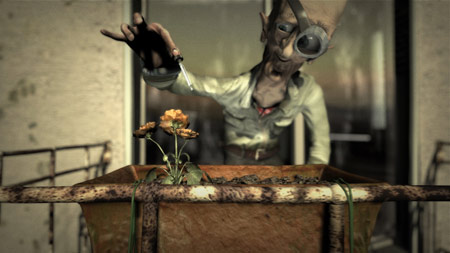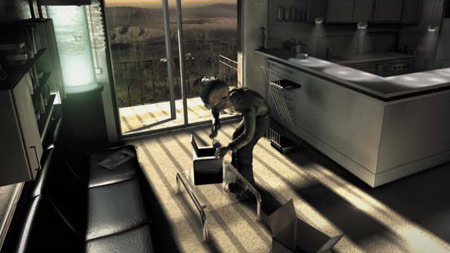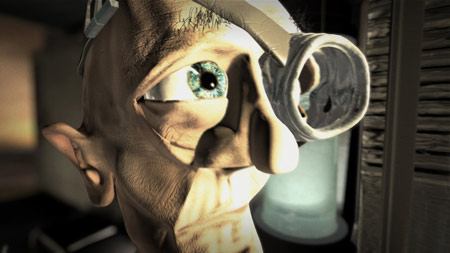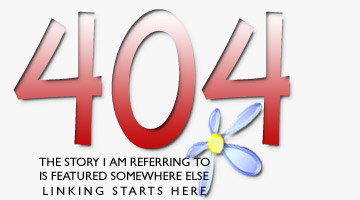DELIVERY is a short 3D movie that really rocked my world. I was amazed by the simplicity of the concept, as well as by the detailed drawings and smooth footage. The movie totally rules. That’s why I had decided to upload the full version to YouTube and start doing a series on splendid 3D shorts, with a small interview from the creator as an extra. I contacted Till Novak, rendered in 3D by his parents in 1980, but he kindly asked me to take down the movie because he was in the middle of trying to sell it. In exchange I’d get an exclusive interview. So I took down the movie and waited patiently until I got the answers on the eleven questions I asked. And here they are. Meet Till Novak, the creator of ‘DELIVERY’.

1.When & how did you decide this was ‘your thing’? When did you decide to become a 3D artist?
I began to work with all kinds of digital art around the age of 15. I always was extremely fascinated by 3D animation. I started to do a lot of classical 2D design and sometimes a little bit of 3D, but it took me 5-7 years of try-and-error-working until I could really offer professional 3D work to my clients. It was very hard to me to discover the complex field of 3D software because I didn`t know anybody to show me some tricks and had to find it out all by myself. Now I have a lot of people around me to ask if there is a problem and from a certain point on especiall online forums like cgtalk.com or www.3dmax.de (german) were extremely helpful.
2. What is your favorite movie and why?
I love to be thrilled by films that are told so clever and constructed so precisely that it makes me feel as if the director knows how to build up a complete world.
My pulse went never higher in cinema than in “Das Experiment” by Oliver Hirschbiegel and “The Game” by David Fincher because in my eyes it has the most thrilling movie ending I have ever seen. One of my alltime favourites also is David Finchers “Fight Club”, because it is so intelligent and thrilling by telling a story as if you were watching in the narrators brain.
The production began in September, 2004 with the storywriting but the final rendering wasn’t finished until February, 2005 after 6 months of working day and night. It’s been produced in 1280×720p resolution and I used 3ds max 7 and Adobe After Effects. It was made using 50% keyframing and 50% motion capturing.
3. What’s the idea behind DELIVERY? Is it based on something or is it a unique concept? How did you come up with it?
Developing a story is always difficult for me. I am not a trained writer so instead of writing a story to the end I always think about other ideas and jump between them, not being satisfied with any of them. I wrote different short concepts when I was spending holidays in Khao Lak / Thailand and one of them was DELIVERY. It was not based on anything, I just had certain images in my mind that I wanted to be part of the story, such as a big city, a bridge between dimensions, a poor old character, etc. In the end it is a story about the power and powerlessness of the individual combined with the fascination about philosophic theories concerning the existence of our universe. Sometimes I wonder how simple the story is and nevertheless causes some attention.

4. The intro sequence is very cool, it sets the tone just right for the rest of the story… how long did it take you to come up with this very long shot?
The Intro sequence is my favourite shot in DELIVERY: The flight through some kind of huge jungle which ends seamlessly introducing the hermit on the balcony with the small flower. This sequence was developed very late during the production and it is a good example for the ideas that had not been in the story board and came up spontanious but make a very important part of the final result.
It contains some hidden information about the story. The flower which reappears in the end is already focused. The motif of a small object to appear very big is already visible here. The sunlight shining through the leaves is a symbol for the ending of the story when the sun comes out again. I am happy that many people recognize the parallels to my favourite directors, Fincher and Jeunet. This sequence for example is comparable to Fincher’s title sequence for “Fight Club”, which also features a seamless macrolense-shot that includes hidden information about the final conclusion.
5. Andreas and Matthias Hornschuh made the music for DELIVERY. How long did it take them and did they compose it to your directions or did they have all possible freedom?
My university gave me 6 months to complete DELIVERY from the storywriting to the final rendering. After 4 months I had a lot of final renderings combined with cheap prerenderings to a almost finally timed version. So they could start producing and it took them about 6 weeks to complete it all. I told them that I wanted a dark, wide, emotional, orchestral score. There were not too many changes on their first draft, except the middle part of the story which had to be rewritten because the idea with the torch was again one of the things which came up very late during the production. If you have questions about the music you can contact the brothers at www.hornschuh-musik.de

6. DELIVERY pictures a rather dirty and mechanical image of the future. Do you think this is how we’ll end up?
There will always be beautiful parts and bad parts in the world. And many parts of our world already look – or at least feel – like in DELIVERY, except the little flying vehicles which came more out of “cultural” science-fiction inspirations instead of realistic future forcasts. One aspect of the factory city of DELIVERY is that you can see no humans in it. This is just an exaggerated way to express the inhumanity that exists already today.
7. Can you line up the chronological evolution from original idea to finished concept to help new artists and interested people understand the process from the birth of an idea to the ultimate creation of it?
The first and most important part is to develop a story. I always spend weeks or months to do that because this process is responsable for what you spend your next 1 or 2 years with. I am not motivated to start design or modelling until I have the feeling about the right story. But to be honest many good details develop during the production, but there has to be the right base idea and most important: the right idea for an ending. To make it really thrilling you need a good ending. After that I make a rough storyboard with simple 3D models, because I am a bad drawer. So I just let out the part of drawing skribbles and designs and proceed to work directly on the final 3D models. This means that I use my 3D software as my sketchbook and start modelling from my brain. This is only possible because I work alone on my shortfilms and I am a fast modeller. While modelling and animating the scenes I already send the first scenes to the render farm. I used 10 PCs to render DELIVERY and they started to render after the first month of the production. In the end there is a long phase of fine-tuning, compositing and correcting which is important to make it really round. At least one third of the production time is just working on these little tunings.
But after all of that the work is just about to begin, because entering the film to many shortfilm festivals all over the world and travelling to the festivals is very expensive and exhausting, but it also is great fun and extremely important for your way as a filmmaker. For DELIVERY I produced 6 months and travelled 12 months until now, of course working in my office inbetween the festival journeys.

8. What was the hardest part of this clip and why?
The hardest part for me was the character animation. I never modelled or animated a character before. I used motion capturing for the walk and rough movement, but facial animation, hands, eyes, etc. still had to be animated manually and the Mocap Data needed a lot of fixing to fit into my scenes.
9. How many awards did it score by now, and what’s the one you cherish the most?
I got about 10 awards for DELIVERY until now and some exciting nominations are still open, like the nomination for the european film award which is held in Warsaw in December. Every award was very exciting for me, but maybe the best surprise until now was to receive the jury award and the audience award at AFI FEST in Hollywood.

10. Did you learn to manage the software yourself by tutorials, or did you follow courses for it?
I learned it almost all by myself. I just was not in the business and I never did any internship in any company. This “isolated” way of learning CGI Production was hard and took a long time. But I think it forced me to find quick and easy selfmade solutions which makes me very independent from plugins or tutorials today. And on the other hand it made me develop some strange or unusual workflows which probably didn’t come up if I learned it in courses. One of these workflows is for example that I very often sculpt my 3d models directly out of the photo footage (camera mapping) instead of modelling them from a draft or skribble. You can get an impression of this effective workflow here or here. This special workflow lets the texture do most of the work but also has its limits and sometimes creates messy geometry.

11. What are your favorite websites/weblogs? What do you read? (e-books and books)
I am sorry but I am almost reading nothing, because I just spend all my time working. I am a little bit ashamed about it, but its true.. :)
More info:
DELIVERY Trailer (.WMV, 8 MB)
A panoramic Quicktime (360°) of the weirdo’s room
Press Kit
Till Novak’s site
